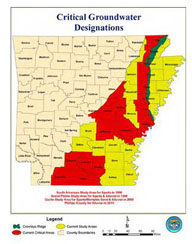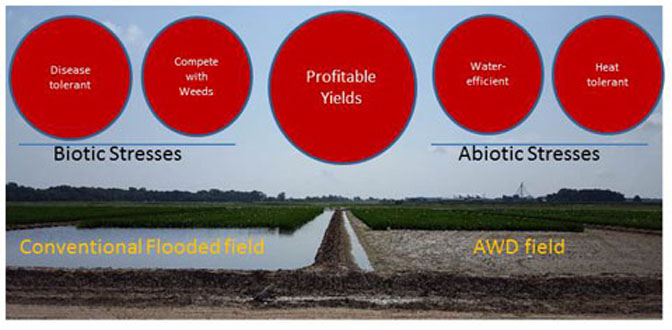| Rice Abiotic Stress Tolerance |

|
Jai S. Rohila and Tiffany Sookaserm
Problem: The groundwater is being used for drinking and irrigation. The figures below show the areas of water pumping and water-level decline (dark shade) in Mississippi River Valley alluvial aquifer. The water-level decline follows the ground water pumping trends, in the state of Arkansas. Because most rice is produced under flooded field conditions, some counties producing high rice acreage have been designated as “running out of groundwater”.
 |
 |
 |
Probable solution: Alternate-wetting-and drying (AWD) is a water management practice where water is applied to flood the rice field, and then the water is left to subside through natural percolation and evapotranspiration until the soil reaches to a target moisture level, at that time the field is reflooded. Studies have shown that this method can reduce irrigation water use by over 20% without affecting grain yield.
Goal: Effective and profitable rice production by using more "Green Water"
|
|
|
Conventionally rice is grown under flooded system primarily using the water withdrawn from surface and ground/ aquifer (Blue Water). This production system is least efficient in utilizing the water that become available periodically from rainfall (Green Water) during cropping season. Our current goal is to search for novel agronomic and physiological traits and molecular markers/genes that are helpful in capturing Green Water efficiently. These traits and markers/genes can be employed to improve rice varieties for production under AWD water management system. Improved varieties under AWD practice will result in profitable rice production with minimum use of underground water resources. |
Research Approach:
I. Searching global rice germplasm for desirable QTL/genes for high yield under AWD and heat stress: Through an extensive pedigree-relationship study of 140 U.S. rice accessions it was concluded that all parental germplasm in US can be traced back to only 22 or 23 introductions (Dilday 1990). The aus subpopulation has a high level of drought tolerance compared to other O. sativa subpopulations. Although aus germplasm has not been used in US rice breeding efforts because of its lack of adaptation in US environment, it may serve as an excellent genetic resource for novel gene/allele discovery and trait development to increase agronomic productivity of US rice under AWD practice, and to increase tolerance to high temperatures during rice growing season. A panel of about 150 aus accessions is being assembled for its characterization for useful traits and to discover QTL/genes to enhance performance of US rice under AWD and heat stress. Collaborators: Anna McClung, Jeremy Edwards.
Click here to see more information on Rice Abiotic Stress Tolerance.

